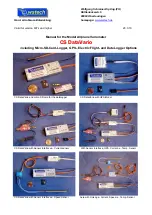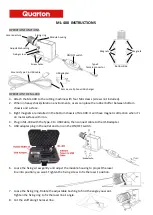
either a detailed map, a GPS navigation system or Google Earth. It is advisable to practice this procedure
under “normal” conditions.
Disturbing position announcement before take-off are suppressed until the model has left the take-off altitude
by plus or minus 10 m/30 ft. If a position announcement is needed on the ground, a piece of tubing may be
connected to the TEK port and with a weak sucking action with the mouth, take-off is being simulated. After a
delay of about 2 to 3 minutes, the local position is announced in 2-minute-intervals.
The announcement is performed as a sequence of numbers only, with the latitude first and then the
longitude in degrees an minutes with four figures after the point.
Example: “47 degrees 43 point 5678 minutes 009 degrees 22 point 4921 minutes”
In all operating modes, the position data is continously stored in a background memory which means that
after a R/C failure or a loss of GPS reception after a crash, the latest position is announced and repeated in
2-minute-intervals.
6.3
Glide Ratio Measurement and Announcement
This feature is available only in conjunction with the WSTECH GPS module.
The glide ratio is a number which indicates the amount of meters flown forward while losing one meter of
altitude.
The glide ratio is measured over a time frame of 100 seconds and announced thereafter.
This mode is selected by entering the standby mode first with a direct switching into the integral mode.
After 100 seconds of a successful measurement cycle, the announcement will be for example “glide ratio 23”
which means that the sailplane moves 23 meters forward while losing 1 m of altitude.
Any interruption of the GPS contact generates a double tone which signals a restart of the measurement
cycle.
This mode gives meaningful information only when used in calm air and when flying very wide patterns.
Narrow circling should be avoided in order not to disturb the GPS contact.
6.4
GPS Module Installation
The GPS module can be connected to the vario either directly or via the WSTECH sensor interface. The
antenna must have an unobstructed “view” towards the sky and it cannot be used behind carbon fiber
material. In case the model has a carbon fiber canopy, you may want to consider replacing a 1”x 1” section
with a glass fiber window. Another solution would be to ask the manufacturer for a replacement canopy from
glass fiber. Laminates with glass- and aramide fibers and thermoplastics cause no problems.
The GPS module should be positioned in the fuselage as high as possible above the wiring and not at the
bottom in order to provide an unobstructed view to the horizon.
6.4.1
Additional Notes for GPS Module Operation
•
Also without a GPS contact (i.e. within a house), a correct connection between the GPS Module and
the sensor interface will generate a lengthened fifth “beep” during the vario start-up and followed by
two short beeps. The second short beep signals that the GPS module has been recognised and it is
signalled by the announcement “sensor interface and GPS recognized”.
•
Connecting the GPS directly to the vario will also generate a lengthened fifth “beep” during start-up,
however without any further beeps. The announcement is “GPS recognized”
•
Caution:
If the GPS module has not been in operation for a long period of time, the buffer battery
might have run low and the first start-up of the GPS might not be recognised by the vario. During a
second start-up after a brief charging time the vario will recognize the GPS module.
•
If the GPS module is started in a new position, there is a possibility that the GPS start-up will take
several minutes. In rare cases where only a few satellites are within range the start-up may take up
to 30 minutes.
•
GPS with green LED: Without GPS contact, the LED will blink and no announcements are made.
GPS contact will switch the LED to a solid green and speed announcements will be made.
•
GPS with red LED: The GPS moduel is ready when the solid red LED starts blinking.
•
On the first reception of valid data, a single announcement “GPS o.k.” will be made.
•
The GPS module is measuring the two-dimensional speed in relation to the ground. It is sufficient to
fly horizontally for 1 second in order to measure the maximum speed. For an accurate measurement,
it is advisable to avoid steep dives with a hard transition into horizontal flight as the sudden “change
of sight” might change the satellites used for the measurement and thus cause errors. This also
applies to circling at high bank angles and stunt flying.








































